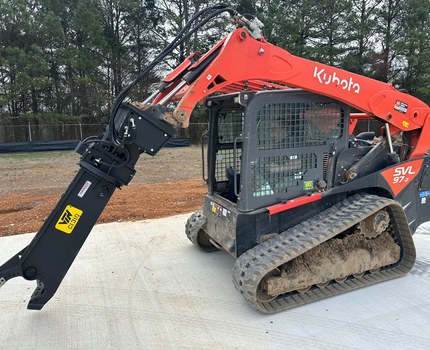Increasing the Lifespan of Your Skid Steer Tracks
Posted by Hailey Miller on 24th Aug 2023
As an equipment operator, you're no stranger to the importance of preserving the functionality and durability of your machinery. Among the critical components that warrant your attention are your skid steer tracks – the workhorses that bear the weight and navigate diverse terrains. By implementing a few savvy practices, you can significantly extend the lifespan of your skid steer tracks, ensuring optimal performance and minimizing maintenance costs. Here are three invaluable tips that can revolutionize how you care for your skid steer tracks.
1. Get the Tension Right: Not Too Loose, Not Too Tight
Track tension might seem like a minor detail, but it's a fundamental factor in the health and longevity of your skid steer tracks. Tracks that are too loose or too tight can lead to an array of issues that jeopardize your equipment's performance and longevity. Finding the perfect balance is the key to success. Tracks that are too loose risk de-tracking, resulting in instability and potential damage. Conversely, tracks that are overly tight accelerate wear on sprockets, rollers, and the tracks themselves.
Refer to your manufacturer's guidelines for the recommended tension setting, and ensure you adhere to these specifications diligently. Regularly inspect and adjust the tension as necessary, considering variables such as terrain and workload. By maintaining optimal track tension, you're laying the foundation for tracks that stand the test of time and operate at their best.
2. Keep It Clean: A Little Effort Goes a Long Way
Your work environment often subjects your tracks to mud, grime, and challenging conditions. While these conditions are par for the course, they can lead to significant wear and tear on your skid steer tracks over time. Accumulated mud, when allowed to dry, can harden and lead to rubber cracking and track damage. Prioritizing routine cleaning of your tracks and undercarriage can be a game-changer for longevity.
After a day's work, take the time to thoroughly clean out mud and debris. Utilize a high-pressure hose or a brush to dislodge caked-on dirt. Not only does this prevent deterioration, but it also ensures your tracks maintain their flexibility, thereby offering optimal traction and peak performance. Consistent cleaning isn't just a minor chore; it's a preventive measure that pays off exponentially over the long haul.
3. Gentle Turns for Longevity
The way you navigate your skid steer plays a pivotal role in the wear and tear experienced by your tracks. Sharp turns, while expedient, inflict considerable stress on the junction where the sprockets interact with the tracks. This stress can hasten track wear and even lead to damage. Instead of opting for abrupt turns, consider adopting the practice of making 3-point turns.
Although 3-point turns might take a tad more time, they distribute stress more evenly, minimizing strain on critical components. This seemingly simple alteration in maneuvering can translate to substantial savings in terms of track replacement costs and overall equipment health.
In conclusion, your skid steer tracks are linchpins of performance, and by incorporating these practices into your maintenance routine, you're setting the stage for extended track life and optimal skid steer operation. From ensuring precise tension to maintaining a clean undercarriage and embracing mindful maneuvering, each tip contributes to a healthier, more efficient skid steer. Remember, by giving your tracks the attention they deserve, you're investing in more than just components – you're investing in the seamless operation and longevity of your entire skid steer system.









